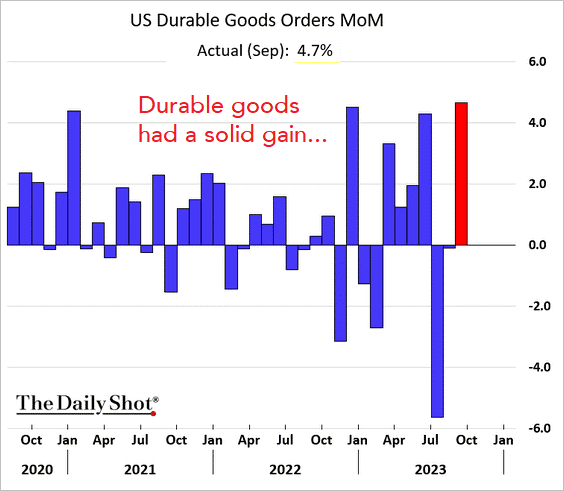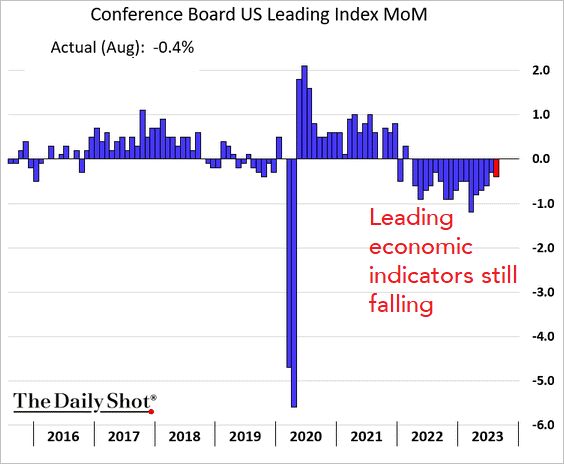Hello all - we hope you had a nice November.
Finally, a nice month for investors! All three indexes turned in their best months in over a year. For November, the Dow rose 8.8% to close at its highest level of the year. The S&P 500 gained 8.9%, and the Nasdaq, which has a higher concentration of tech stocks, added a solid 10.7%.
Finally, a nice month for investors! All three indexes turned in their best months in over a year. For November, the Dow rose 8.8% to close at its highest level of the year. The S&P 500 gained 8.9%, and the Nasdaq, which has a higher concentration of tech stocks, added a solid 10.7%.
Here’s a look at how the markets moved this month:
A significant amount of the gain in the market has come from only a handful of stocks. The top seven stocks in the S&P 500 have gained about 80%, while the remaining 493 stocks have gained about 6%. This has been a very concentrated rally, which isn’t very healthy.
Bonds were again a big story this month. For the last few months, they were a big story because bond yields were rising at a record pace, meaning it was rapidly becoming more expensive to borrow money.
This month, however, bonds reversed course sharply. Yields dropped and bond prices rose.
This month, however, bonds reversed course sharply. Yields dropped and bond prices rose.
When bond yields fall, bond prices rise. For investors in bond index products, like bond ETF’s, that means the ETF price moved higher. Here’s a look at the price the most popular bond ETF, the Vanguard Total Bond Index:
____
FED
So why the reversal in stocks this month? There are a couple things we could point to like decent corporate earnings or economic data that still looks good. However, the biggest reason for the gains is the Fed.
Investors believe the Fed is done raising interest rates. At least, that was the main takeaway from a Fed policy meeting at the beginning of the month. That gave investors the green light they had long been looking for and markets shot higher.
____
INFLATION
Inflation has been helping the Fed, too, as inflation has moved lower. On a year-over-year measurement, inflation moved lower again this month after being flat or higher the previous three months.
Inflation is trending lower on a monthly measurement, too.
____
OTHER ECONOMIC DATA
The economy remains in a weird spot. Economic growth continues to look fine. GDP has been solid and employment figures still look decent.
Many commentators are calling this a “soft landing.” There was a worry when the Fed stopped its stimulus that the economy would crash, or have a “hard landing.” Obviously that hasn’t happened, hence the phrase “soft landing.”
However, we think it’s too early to think we are in the clear. For months we’ve shown many economic indicators that only happen in recessions. We have a few new ones this month.
First is a chart of Gross Domestic Income (or GDI). Without getting too far into the weeds, it’s like GDP, but it measures the income that is earned in getting GDP. You can make GDP look better through government spending, but that isn’t possible with GDI.
Anyway, real GDI recently turned negative and it only does that in a recession (in the chart, the periods that are recessions are marked with the gray shading).
First is a chart of Gross Domestic Income (or GDI). Without getting too far into the weeds, it’s like GDP, but it measures the income that is earned in getting GDP. You can make GDP look better through government spending, but that isn’t possible with GDI.
Anyway, real GDI recently turned negative and it only does that in a recession (in the chart, the periods that are recessions are marked with the gray shading).
Another red flag comes from the Beige Book, which is a way the Fed gauges economic activity. A Beige Book indicator turned negative and only does that during recessions.
Then there is the leading economic indicators, which we’ve talked about for months. This index combines many other indicators that tend to signal the direction of the economy (like weekly unemployment numbers, building permits, etc.).
This index has been lower for 19-straight months now. It has never gone this low without a recession following.
This index has been lower for 19-straight months now. It has never gone this low without a recession following.
Here are the various indicators used in the leading indicator index:
The strength of the manufacturing and service sectors of our economy had been improving, but both turned lower in the most recent data.
Retail sales were lower last month:
Durable goods (these are items with a longer life, like a phone or refrigerator) were down, too.
Amid all the negative data, consumer confidence moved higher:
Small business optimism was slightly lower, though:
____
Where does the market go from here?
Stocks were very oversold (cheap) at the beginning of the month, only to move to very overbought (expensive) levels here. This is usually not a good time to put new money in the market.
That said, this is a very peculiar time of the year. Money tends to flow into the market at the end of the year and push stocks higher. You can see this in the chart below (the light blue line is the average of the market since 1950).
The green light from the Fed earlier this month likely encourages more new money into the market, too.
So, while we think stocks are very overbought, it’s possible they could rise into the year end. However, we’d prefer to wait for better buying opportunities.
This commentary is for informational purposes and is not investment advice, an indicator of future performance, a solicitation, an offer to buy or sell, or a recommendation for any security. It should not be used as a primary basis for making investment decisions. Consider your own financial circumstances and goals carefully before investing. Past performance cannot guarantee results.
So, while we think stocks are very overbought, it’s possible they could rise into the year end. However, we’d prefer to wait for better buying opportunities.
This commentary is for informational purposes and is not investment advice, an indicator of future performance, a solicitation, an offer to buy or sell, or a recommendation for any security. It should not be used as a primary basis for making investment decisions. Consider your own financial circumstances and goals carefully before investing. Past performance cannot guarantee results.


































































